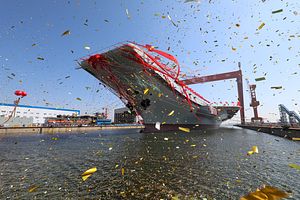On Wednesday morning, China launched its first indigenously built aircraft carrier, the Type 001A. The carrier will be the second overall to join the People’s Liberation Army-Navy, following the Liaoning, a refurbished Soviet Kuznetsov-class carrier that was commissioned into the PLAN in 2012. The Type 001A’s launch comes three days after the PLAN’s founding anniversary on April 23.
The carrier’s “launching” ceremony still leaves it far off from entering operational service with the PLAN. On Wednesday, the carrier was tugged out of its drydock into the water at Dalian port. The Type 001A was built at the Dalian shipyard in Liaoning Province by China Shipbuilding Industry Corporation, a state-owned shipbuilding conglomerate.
The PLAN’s website noted that Gen. Fan Changlong, vice chairman of the Central Military Commission, presided over the launch ceremony on Wednesday. Vice Adm. Shen Jinlong, the head of the PLAN, attended as well. Vice Adm. Shen, who notably has experience in expeditionary operations, including leading PLAN delegations to the Rim of the Pacific exercise in 2014, succeeded Admiral Wu Shengli as the head of the PLAN in January 2017.
As I’d discussed earlier this week, the Type 001A — likely to be formally named the Shandong — is an important development for China’s naval strategy, which is increasingly geared toward expeditionary operations beyond the first island chain and even into the Indian Ocean. China’s 2015 white paper on military strategy identifies this in no uncertain terms:
It is necessary for China to develop a modern maritime military force structure commensurate with its national security and development interests, safeguard its national sovereignty and maritime rights and interests, protect the security of strategic SLOCs and overseas interests, and participate in international maritime cooperation[…]
It’s natural for quite a bit of attention to be focused on the capabilities of the Type 001A. Aircraft carriers, after all, are as much a prestige item for navies as they are an important enabler for far-flung power projection. However, the Type 001A, with its rudimentary ski-jump launch system for the PLAN’s Shenyang J-15s, is really an iterative improvement on the Liaoning.
These carriers, as I’ve explained before, will nevertheless serve an important purpose for the PLAN, which has had little experience operating carriers. Despite the PLAN’s ever-growing hull count and ambitions, it will struggle to transform itself into a carrier-based navy without its sailors and naval aviators getting adequate training time aboard real carriers.
The Liaoning has already been serving this purpose. That carrier spent December 2016 transiting south from its home port of Qingdao to Hainan Island via multiple important first island chain choke points, including the Miyako Strait and the Bashi Channel. It also passed through the Taiwan Strait on its way back north to Qingdao.
As far as capabilities go, China’s anticipated third carrier is the one to watch. That carrier may iterate past a ski-jump short take-off but arrested recovery (STOBAR) system and introduced a steam catapult (CATOBAR), enabling faster sortie rates and greater payloads for its air wing. This carrier — dubbed the Type 002 — would presumably launch later in the decade.
The PLAN’s final carrier force is expected to range between four and six ships. Beyond its Shenyang J-15s, China is also thought to be developing airborne early warning and control (AEW&C) aircraft for its Type 002 carrier.
































